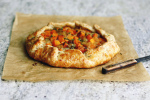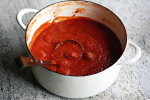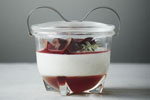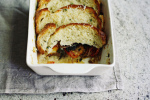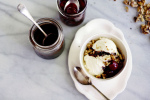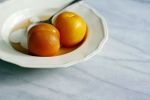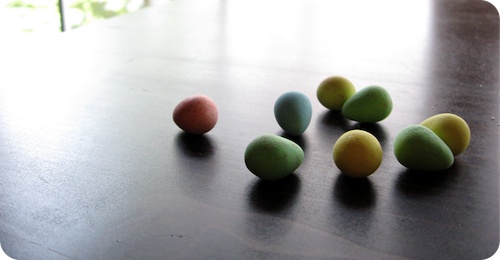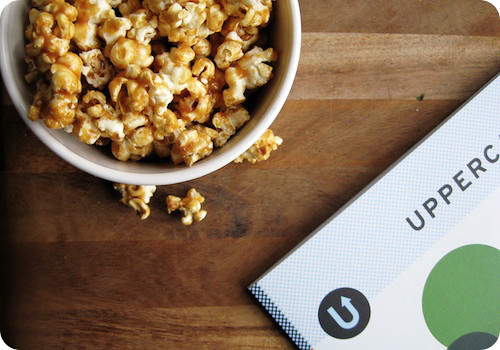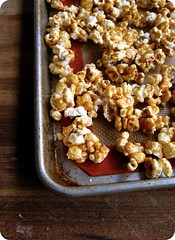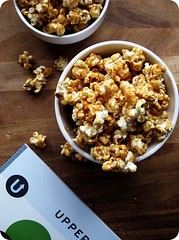One ribbon-tied package (and a winner!)
 Tuesday, April 21, 2009 at 10:18PM
Tuesday, April 21, 2009 at 10:18PM 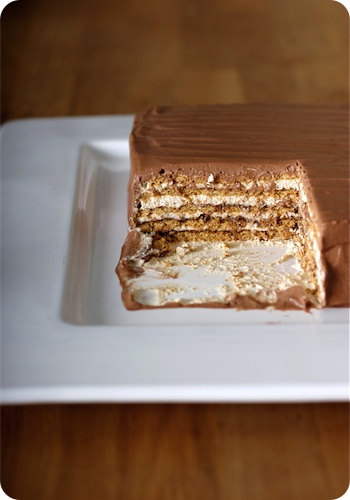
Thanks to my sis-in-law Rene, for not only hosting the dinner tonight, but also being our photographer. She's especially snazzy.
Sorry about this. Really.
I know, we were chatting about chocolate and coffee just a few days ago. And it seems as though I have had sweets on the brain for weeks now.
But, if ever was there a day when maybe, just maybe dear reader, you could cut me some slack for my repetitive ways, I hope it will be today. Because really, who would begrudge a birthday girl her chocolate wish?
That's right, today was my birthday.
Please excuse my sweet tooth and forgive me for being a trifle scatterbrained just now, but I wanted to stop in to share with you the dessert we chose to celebrate.
Our fancy-dress festivities are not for another few days, so today is all about a night just for family. And for me, if there is one dessert that ties together my thoughts of family and nostalgia all in one ribbon-tied package, it would be my Mum's Mocha Dessert.
When I was little, this Mocha Dessert was the often-requested sweet ending to my parents' dinner parties, parties I considered the height of elegance. Silver was polished to perfection, the good china was brought out, and the menu were planned days in advance. When the night arrived, the men were dapper and the ladies were always dressed to the nines; you can surely imagine how my six-year-old self loved the glamour of dark lipstick and dangling baubles.
I remember their conversations lasting into the night. The deep murmur of their voices, often punctuated by peals of sparkling laughter, made its way through the darkness, up the stairs and to my ears as I strained to catch what was surely exceptionally witty banter. I thought it all terribly romantic.
As an adult, I can appreciate why this simple recipe was the subject of such praise. Layers of graham crackers were sandwiched with coffee cream and drizzled with chocolate sauce. After a night's rest in the icebox, the formerly-disparate components relax into each other. The graham crackers loose all their crispness, the cream turns thick and luscious. In the end, everything is mousselike, with a delicate delineation of layers that yield to the slightest pressure from a spoon. A cross between an icebox cake and a tiramisù, I strongly believe that it was this ethereal confection that started my love affair with coffee.
This cake is ridiculously easy to make and decidedly old school. It is not about bells and whistles, or technique and the latest trend. Instead, like all fond memories, it simply makes me smile.
Of course I had a little bit of business to attend to today, and that is the announcement of the winner of the giveaway. I am happy to say that Random.org has selected Angela as the recipient of a one-year subscription to the food magazine of her choice. Angela, please contact me at tara [at] sevenspoons [dot] net with your contact information.
Thank you to everyone that entered and a here's wishing a happy day to each and every one of you!

Mocha Icebox Cake
Adapted, with thanks, from my Mum. Hers was made and served like a tiramisù, with more cream and less cookie, scooped out for serving. I have turned the dessert out on its head, and added some chocolate whipped cream.
Ingredients
3 1/2 cups heavy (whipping cream), divided
3/4 cup confectioner's sugar, divided
1 tablespoon instant coffee granules
a pinch of salt
1 teaspoon vanilla extract
45 honey graham crackers, the single kind
1/3 cup chocolate syrup, see note
1/3 cup cocoa powder, sifted
Line an 8-by-8-inch metal cake pan with a cross of clingfilm, leaving an overhang on all sides. Set aside.
In the bowl of a stand mixer with the whisk attachment, or in a medium bowl with a hand blender or whisk, begin to whip 2 cups of well-chilled heavy cream. Once the cream begins to thicken, sift in 1/2 cup confectioner's sugar, the coffee granules and salt. With the mixer on medium-high, whip until the cream begins to hold soft peaks. Add the vanilla, and beat until the cream just holds a stiff peak.
Spread a small amount of the cream on the bottom of the prepared cake pan. Lay 9 crackers, in a 3-by-3 grid, on top of the cream. Spoon 1/2 cup of the cream on top of the crackers. Then, using an offset spatula, gently spread the cream to cover the crackers entirely. Drizzle a few tablespoons of the chocolate syrup over the cream, spreading to form an even layer if desired.
Top with another layer of graham crackers, continuing the layering until you have 5 layers of crackers and 4 of the cream and chocolate. Make sure to reserve a small amount of cream to cover the last layer of crackers (no chocolate on this one).
Cover loosely with a piece of clingfilm, then draw the overhanging clingfilm from the sides up to cover the edges. Refrigerate for at least 6 hours and up to 2 days.
About 1 hour before serving, remove the cake from the fridge and peel back the clingfilm. Invert the cake onto a serving plate, removing the remaining clingfilm from the top and sides. Smooth out the sides with an offset spatula if needed. Place the cake in the freezer, uncovered, to chill for 30 minutes.
Prepare the cocoa cream. In the bowl of a stand mixer with the whisk attachment, or in a medium bowl with a hand blender or whisk, begin to whip 1 cup of well-chilled heavy cream. When the cream begins to thicken, sift in the reserved 1/2 cup confectioner's sugar and cocoa powder. With the machine set to medium-high, whip the cream until holds a firm peak, but being careful not to over beat.
Take the cake out of the refrigerator and gently spread a thin layer of the cocoa cream to cover. Once completely covered, use the remaining cream to decorate as desired. Chill the finished cake in the refrigerator for 30 minutes, then serve.
Notes:
• If you are going for authenticity, my Mum used Hershey's Chocolate Syrup (the dessert topping in the yellow tin, not the brown squeeze bottle). But if you are feeling posh you can make your own using one of these recipes.
• For the sake of honesty, I will say that maybe I went a little overboard and used a full 2 cups of cream for the cocoa frosting. The last 1/2 cup looked so sad in its carton, and heck, you only have one birthday a year. Totally not necessary to the cake, but enjoyably decadent. To follow suit, add a bit extra cocoa powder and confectioner's sugar, to taste.
• A pinch or two of instant coffee granules added to the cocoa cream is also a good thing.
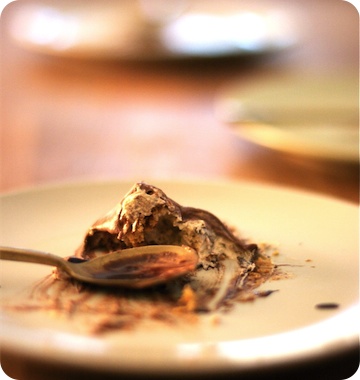
 Mum,
Mum,  birthday,
birthday,  chocolate,
chocolate,  dessert,
dessert,  graham cracker,
graham cracker,  icebox cake,
icebox cake,  mocha,
mocha,  nostalgia,
nostalgia,  recipe
recipe 

